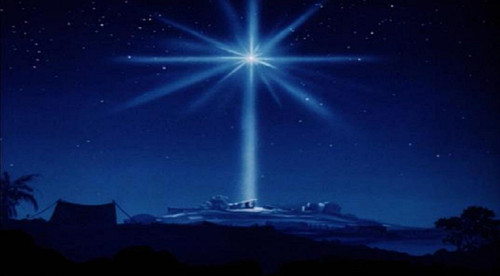Nativity of Christ - the history of the holiday to the present day
The history of the feast of the Nativity of Christ has been known since the emergence of Christianity. Since the 4th century, the holiday was called the Epiphany, was celebrated on December 25 and was a combination of several events, which today are known as three separate holidays: Epiphany (Baptism of the Lord), Annunciation and Christmas.
The appearance in the flesh of the Son of God, the remembrance and glorification of this event is the main and initial goal of the bright feast of the Nativity of Christ. But there is also a secondary goal, which we will find out in this article.
When Christians Celebrate Christmas
How many Christians celebrate the Nativity of Christ - in the modern world in different ways. Most use the Gregorian calendar when calculating the date of the holiday, which was created in the XIV century. According to this calendar, secular society lives in most countries of the world - including in Europe and Russia. According to the Gregorian calendar, Christmas is celebrated on December 25 - this is a tradition among Catholics and some other confessions. The Western Church has preserved an amazing tradition of celebrating Christmas at the state level - with street decorations, public festivities and sincere joy. Europeans celebrate this holiday with the same scale as they celebrate the New Year in Russia.
In Russia, the tradition of calculating events according to the solar Church Slavonic calendar, which was introduced by Julius Caesar in 45 BC, and which bears his name - Julian, has remained in Russia. According to this calendar, following the guidance of the apostles, the Christians of the Eastern Church calculate the holidays. The Orthodox holiday of the Nativity of Christ is January 7, although, according to the old style, this date also fell on December 25. The new style was introduced in Russia immediately after the 1917 revolution; after the innovations, the time shifted 14 days ahead. This holiday is considered to be twelve, it begins on Christmas Eve the day before - January 6th. On this day, Christians fast until the first star, and then eat a special dish - syrupy. Nativity of Christ is preceded by a 40-day fast. On the night of January 7, at the festive service, Orthodox and Christians of other confessions of the Eastern Church celebrate the holiday of Christmas and go home to celebrate it with all the luxury - now the fast is over, and you can have fun all night.
A Brief History of the Nativity of Christ
The history of the Church of Christ knows many discrepancies with the true teaching of the apostles; it was expressed in the distortion of general theology and, as a result, the very teaching about Christ was distorted. This also became the reason that the holiday was separated from the general celebration of the Incarnation, which combined three events, and Christmas was introduced separately.
The separation of the holiday took place in the 4th century under Pope Julia. By setting the date for the celebration to December 25, the Church created a counterbalance to the sun worship that pagans celebrated on this day. The celebration was so popular that even Christians took part in it, thereby sinning against the second. Thus, the introduction of the feast of the Nativity of Christ replaced the pagan tradition of celebrating the winter solstice and turned the hearts of people to the true God.
The day for the holiday was extremely symbolic and logical - after all, the symbol of the sun, like no other, befits the memory of the event of Christmas, since Christ is the Sun of righteousness, the Light of the world, the Conqueror of death - as the apostles call Him.
According to the great Christian minds of world magnitude, such as John Chrysostom, Blessed Augustine, St. Cyril of Alexandria and others - the date of Christmas on December 25 really has a high historical reliability in calculating the day of the Nativity of Christ.
The introduction of the chronology from the Nativity of Christ took place in the year 525 and is associated with the meaning that it had for all mankind. Two eras - before the Nativity of the Messiah, before the possibility of eternal life and forgiveness of sins - and after. The monk Dionysius the Small, who calculated the events in order to put them in the basis of the new calendar, made a mistake with the calculations - to be precise, now it is 4 years earlier than it is commonly believed, and the current time account has this error. But the event, nevertheless, remained the main one in the history of mankind - that is why the chronology is dated from the Nativity of Christ.
Symbols of the Nativity

The following most famous symbols of the Nativity of Christ can be listed:
- elegant tree;
- presents;
- Star of Bethlehem;
- nativity scene;
- angels and shepherds.
The history of the emergence of spruce, as an attribute of Christmas, comes from the Western tradition, which did not develop immediately, and was associated with peoples' ideas about evergreens as a symbol of immortality, eternal life. That is, exactly what became possible with the coming of the Savior to this world.
Gifts were brought to Christ by the wise men - Persian healers, representatives of Zoroastrianism - the world's first monotheistic religion, intended for all peoples, and not just for the Jewish. They studied astrology and calculated the Birth of the Messiah, which was predicted in their religion. The Magi brought with them gifts to the Christ Child - attributes that symbolized three important qualities that He possessed. It was:
- gold to the King;
- incense - to the Priest;
- I will myrrh - to the Man who must die.
Smyrna is a very fragrant resin that was used to pray over dead people and was a symbol of burial. After returning to their homeland, the Magi preached the birth of the Savior. The Church venerates them as "the three holy kings." In memory of these gifts at Christmas, it is customary to give gifts - not because a person behaved well, not for any other reason, but out of love, for Christ's sake.
The Star of Bethlehem is a mysterious heavenly object that led the Magi to Christ. According to one version, an unusual celestial phenomenon happened when Jupiter and Saturn converged at one point. According to the calculations of the astronomer Johannes Kepler, who lived in the 17th century, such a phenomenon could have been possible during the Gospel events. There is a different tradition in the image of the Star of Bethlehem - the 5-pointed star is known, characteristic of the Arab Church, the 8-pointed one is considered a symbol of the Virgin and is depicted in the Orthodox tradition. There are also 6-pointed and other types of the Bethlehem star.
It is reliably known from Tradition that there was no place for Christ in the hotels of Bethlehem, where the Holy Family came to the census of the population, and He was born in a cave (nativity scene) and was swaddled and laid in a manger - a cattle feeder. Therefore, pious Christians put a figurine of a nativity scene with the Infant and the Holy Family under the Christmas tree - in memory of the great event.
According to the gospel narrative:
“In the vicinity of Bethlehem there were shepherds who lived in the field and, replacing each other at night, watched over their flock. And the angel of the Lord stood before them. The radiance of the light of the Lord illuminated them. They were very scared, but the angel told them: “Do not be afraid! I bring you good news - the message of great joy for all the people: today in the city of David your Savior was born - Christ, the Lord! And here is a sign for you: you will find a Swaddled Child lying in a manger. " (Luke 2: 8-12)
The shepherds saw the angels, heard the Great Doxology, the angelic song that people kept, believed and came to worship the Creator first.
"Glory to God in the highest, and on earth peace, good will in men!" (Luke 2:14)
In memory of this event, shepherds and angels became symbols of the Nativity of Christ. They are depicted on Christmas gifts, as decorations on the tree, Christmas figurines and other symbols that are traditional attributes of Christmas.
Nativity of Christ: traditions and customs

At Christmas, they sing carols, decorate the house and streets, prepare a festive meal - these attributes are, perhaps, present in all nations. But how else is Christmas celebrated, and what traditions exist?
It should be noted that in European countries, Christmas is taken very seriously: this holiday is considered the main holiday of the year, it is celebrated at home in a close family circle and it is not customary to invite anyone. Preparing for Christmas includes treats and gifts. On the eve, the whole city is dressed up with Christmas decorations.
On the eve of the feast of the Nativity of Christ, Christmas markets are held in Russia, where you can buy everything related to the theme of Christmas. For Orthodox Christians, the holiday begins on Christmas Eve and ends on Epiphany Eve. All this time - special days of joy, Christmastide.
Christmas Eve is the eve of the holiday, when, according to the pious tradition, ochivo is brewed - a sweet dish made from wheat cereals with honey and dried fruits. Sometimes wheat is replaced with rice. On this day, Christians try not to eat anything until the first star, and then, in the pre-holiday atmosphere, they solemnly set the table and taste juicy. The table is decorated with hay and elements symbolizing Christmas. After the meal, the faithful prepare for the nighttime Christmas service.
Christmastide is a holy day that runs from January 7 to January 18 and is a time of intense joyful prayer, fun pastime with feasts, singing carols and other happy moments. In Russia, Christmas was celebrated with carols and active attendance at services on Christmastide. Today these traditions are being revived among young people and are becoming a popular leisure activity, as can be seen by visiting temples.
The Nativity of Christ is a great holiday, familiar from childhood. This is the second largest after Easter, and the first children's holiday is a time of magic and miracles. It is filled with an atmosphere of expectation of a miracle. Children, whose hearts are always pure, feel it better than others. The history of the feast of the Nativity of Christ teaches us to rejoice and wait for unexpected gifts - for nothing, just like that. Because Christ was born - our common Gift.
